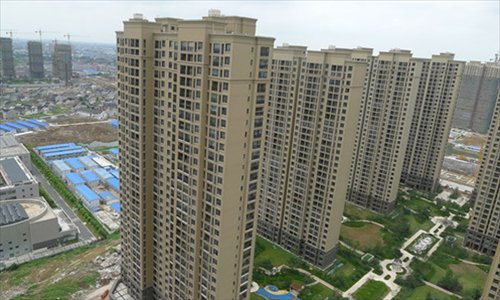

Recently completed skyscrapers jostle with those still under construction in the Changzhou skyline. Photo: Liu Dong/GT
As a taxi driver in Changzhou for a decade, Zhang Weixin never thought his hometown would become a "ghost city" someday. In his eyes, the city seems to be doing better than ever.
Located at the heart of the Yangtze River Delta, the 2,500-year-old eastern coastal city of Changzhou used to be called the Dragon City, for its prosperity and wealth. But it has been facing harsh tail winds recently after some media reports labeled it a "ghost city."
According to a National Business Daily report in January, most newly built residential compounds along Wuyi Road, a new area of the city, had a high vacancy rate as few lights could be seen at night.
However, the Changzhou government soon published an official announcement to refute such accusations, calling it groundless to label Changzhou as a "ghost city" simply due to a lack of lights.
"Most properties on Wuyi Road are just finished or still under construction, it is unreasonable to judge the vacancy rate when the area is still in a transition period," Wu Haiyong, deputy director of Changzhou Housing Administration Bureau said at a press conference in February.
However, this clarification didn't settle the argument among the public and the media as more and more "ghost cities" have emerged nationwide.
According to a China Youth Daily report in July, at least 12 such ghost cities across the country have been found. Besides the best known of these - Ordos in North China's Inner Mongolia Autonomous Region, the list also included Changzhou in Jiangsu, Zhengdong New Area in Henan Province, Shiyan in Hubei and Chenggong District of Kunming in Yunnan.
Despite their varied geographical locations and economic development levels, these cities share one common characteristic: their local governments had all placed a large amount of investment into building new zones filled with commercial facilities, residential compounds and infrastructure. Only one thing is missing, people.
Dragon city or ghost city
When the Global Times visited Changzhou on July 22, one could see many skyscrapers tower toward the horizon along Wuyi Road, displaying the city's ambition to be a real metropolis.
Zhang Weixin seemed torn when asked about the city's largest and newest property project.
"It's everywhere. As you can see, new property projects are all the way along the streets, there are too many of them so I can't figure out which ones are the newest or the biggest," Zhang said.
But at Injoy Plaza, the biggest shopping mall and apartment complex on Wuyi Road which opened in May 2012, a resident named Wang who moved in last year said only one-third of floor space in her building was occupied.
Wang told the Global Times an easy way to judge whether an apartment is really inhabited or not - by counting the air-conditioning units, indispensable in this hot part of China. There are not many to be seen in big compounds with a dozen buildings, each over 30 floors.
One employee from the Tesco supermarket nearby confirmed with the Global Times that business is not good due to a lack of customers.
Property bubble or bust
Wuyi Road is just the epitome of Changzhou's focus on real estate development in recent years. The local authority has introduced a series of policies to encourage developers and buyers.
Changzhou's first subway line will break ground next year and will mainly travel under Wuyi Road. Property developers noted that local authorities have already invested 8 billion yuan ($1.3048 billion) to renovate the surroundings of Wuyi Road.
A manager from Czfcw.com, the city's biggest real estate agency, told the Global Times that some 100 property projects are still under construction in Changzhou now.
Copyright ©1999-2018
Chinanews.com. All rights reserved.
Reproduction in whole or in part without permission is prohibited.